Osprey
Books Recommendation |
||
|
|
|
|
Osprey
Books Recommendation |
||
|
|
|
|
|
|
||||
|
Men at Arms Series |
||||
Frontpage |
Description/contents |
Author |
Publisher |
Buy from |
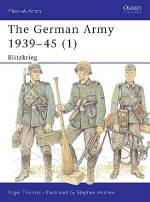 |
Men at
Arms 311 The German Army 1939 - 45 (I) Blitzkrieg On 1 September 1939, when Germany attacked Poland, the Wehrmacht numbered 3,180,000 men. It eventually expanded to 9,500,000, and on 8-9 May 1945, the date of its unconditional surrender on the Western and Eastern Fronts, it still numbered 7,800,000. The Blitzkrieg period, from 1 September 1939 to 25 June 1940, was 10 months of almost total triumph for the Wehrmacht, as it defeated every country, except Great Britain, that took the field against it. In this first of five volumes examining the German Army of World War Two, Nigel Thomas examines the uniforms and insignia of Hitler's Blitzkrieg forces, including an overview of the Blitzkrieg campaign itself. Men-at-Arms 311, 316, 326, 330 and 336 are also available in a single volume special edition titled ‘German Army in World War II’. |
Nigel Thomas |
||
 |
Men at
Arms 316 The German Army 1939 - 45 (II) North Africa and Balkans Hitler first considered an invasion of Great Britain in autumn 1940, then scheduled Operation Barbarossa, the conquest of the European part of the Soviet Union, for May 1941. Anxious to emulate Hitler's successes, the Italian dictator Mussolini embarked upon unnecessary military adventures in North Africa and the Balkans, which forced Hitler's intervention, diverting and depleting precious German resources, and a six-week postponement of Barbarossa. In this second of four volumes [Men-at-Arms 311, 316, 326 & 330] on the German Army of the Second World War, Nigel Thomas examines the uniforms and insignia of the forces involved in North Africa and the Balkans. Men-at-Arms 311, 316, 326, 330 and 336 are also available in a single volume special edition titled ‘German Army in World War II’. |
Nigel Thomas |
||
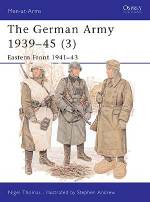 |
Men at
Arms 326 The German Army 1939 - 45 (III) Eastern Front 1941-43 Operation Barbarossa, the attack on the Soviet Union, commenced on 22 June 1941. It became the biggest conflict in military history, with some three million German troops and about 900,000 allies facing almost 4.7 million Soviet troops. The effects would colour postwar European history for the next 50 years. This title examines the history of the conflict, and the organisation, uniforms and insignia of the German Army on the Eastern Front from 1941-43. The book contains numerous illustrations and photographs throughout, incuding eight fine full-page colour plates by Stephen Andrew. Men-at-Arms 311, 316, 326, 330 and 336 are also available in a single volume special edition titled ‘German Army in World War II’. |
Nigel Thomas |
||
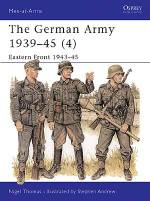 |
Men at
Arms 330
The German Army 1939 - 45 (IV) Eastern Front 1943-45 In early 1943 the annihilation of the 6th Army at Stalingrad marked the irreversible turning-point of the war in the East. Despite occasional local successes gained in the face of great odds – testimony to the Wehrmacht’s extraordinary resilience – from now on Germany was on the defensive. Despite Hitler’s damaging interference the quality of German field leadership, and of new weapons, remained high; but each new Soviet offensive pushed the front line closer to – and finally, across – the borders of the Reich. In this fourth title of their sequence author and artist describe and illustrate the developments in unit organization, uniforms and equipment during 1943–45, including information on European and Eastern volunteer units; text and illustrations are supported by detailed tables. Men-at-Arms 311, 316, 326, 330 and 336 are also available in a single volume special edition titled ‘German Army in World War II’. |
Nigel Thomas |
||
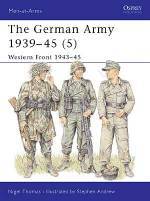 |
Men at
Arms 336
The German Army 1939 - 45 (V) Western Front 1943-45 This book covers the high command, the developments in unit organisation, the campaigns and the uniforms and equipment of the German Army in the last two years of the war in North-West Europe and Italy. Despite the huge pressure of fighting on three fronts, ever-worsening shortages of manpower and equipment, and Allied command of the skies, Germany's decimated divisions fought on with impressive skill and determination. This period also saw a fascinating mixture of obsolescent, newly designed, and field-made combat clothing which gave the German soldier a radically different appearance from his predecessor of just five years before. Men-at-Arms 311, 316, 326, 330 and 336 are also available in a single volume special edition titled ‘German Army in World War II’. |
Nigel Thomas |
||
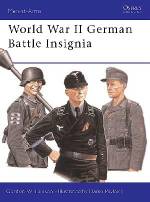
|
Men at
Arms 365
WWII German Battle Insignia The remarkable war effort of the German armed forces on three fronts between 1939 and 1945 was recognised by a wider range of insignia than seen in the Allied armies. While the Wehrmacht displayed fewer unit insignia than the Allies, a glance at a German soldier's tunic could reveal much more about his actual combat experience. In this book an experienced researcher explains and illustrates the Battle and Assault Badges of the Army, Waffen-SS and Luftwaffe ground troops; the sleeve shields and cuffbands issued to mark service in particular campaigns; wound badges, commemorative medals, and other types of insignia. |
Gordon WIlliamson |
||
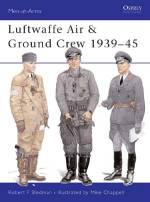
|
Men at
Arms 377
Luftwaffe air and ground crew 1939-45 The Luftwaffe, honed in the Spanish Civil War, played a vital part in Germany's 'Blitzkrieg' victories in 1939-41. Badly overstretched by war on three fronts in 1942-44, it was crippled by an incompetent commander-in-chief, the losses among experienced aircrew, and shortage of fuel. In 1944-45 it faced a final battle of attrition in skies ruled by the Allies as the Eastern and Western pincers closed on the Reich; but until the very end the dwindling band of veteran pilots - among them the greatest 'aces' the world has ever known - presented a potent threat. This fact-packed review of Luftwaffe uniforms and flying kit is illustrated with rare personal photos, insignia charts, and two dozen meticulously detailed colour figures. |
Robert Stedman |
||
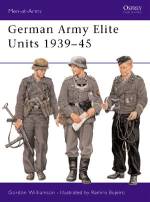 |
Men at Arms 380 German Army Elite Units 1939-45 Contents Panzerkorps 'Gross Deutschland' Panzer grenadier Division 'Feldherrnhalle' Infantries Regiment 'List' Panzer grenadier Division 'Brandenburg' Kavallerie Regiment 5 'Feldmarschall Von Mackensen' Reich grenadier Regiment 'Hoch und Deutschmeister' 116 Panzer Division 'Windhund' 21 Panzer Division 24 Panzer Division (1 Kavallerie Division) Panzer Lehr Division 3 Gebirgs Division 5 Gebirgs Division The Tiger Tank Battalions |
Gordon Williamson |
||
|
|
Men at
Arms 385 The Hermann Göring Division Each of Germany's World War II armed services could claim one unit which earned a unique combat reputation, and which consequently was enlarged and developed far beyond the size originally planned. Hermann Göring, commander-in-chief of the air force, was determined that his Luftwaffe should share the glory of Germany's land conquests, and gave his name to a regimental combat group of infantry and Flak artillery. This élite unit was steadily enlarged into a brigade, then an armored division, and finally into a two-division corps, fighting with distinction in Tunisia, Sicily, Italy, and on the Russian Front. This concise history is illustrated with rare personal photographs and eight colour plates, detailing the very varied uniforms and special insignia of this crack formation. |
Gordon WIlliamson |
||
|
|
Men at
Arms 393 WWII German Women's Auxiliary Services Under the Nazi regime, Hitler's conservative views on the place of housewives and mothers in society limited German women to a much less active role in the war than their British and Allied counterparts. Nevertheless, the demands of a prolonged war did see German women in a range of uniforms as auxiliaries with the Army, Navy, Air Force and SS, particularly in the signals and air defence services. This unique book explains and illustrates these organisations and their uniforms and insignia, as well as Red Cross nurses, and auxiliaries of the Labour Corps, Customs Service, National Socialist Women's Organisation, and League of German Maidens (Hitler Youth). |
Gordon Williamson |
||
|
|
Men at
Arms 401 The Waffen SS (I) 1 to 5 Divisions Despite being disdained by the German Army’s professional officer corps, the military branch of the Nazi SS security organization grew from an initial strength of only a handful of battalions at the outbreak of war in 1939 to hundreds of thousands of troops in dozens of divisions. The battlefield reputation of the premier armored and mechanized divisions would become second to none; lavishly equipped and regarded as utterly reliable, they were thrown into many desperate battles on both Western and Eastern fronts, often achieving remarkable results. Illustrated with rare photographs, this first of four Men-at-Arms titles details the organization, uniforms and insignia of the Waffen-SS. |
Gordon Williamson |
||